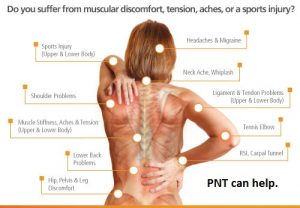Have you ever felt that eliminating your pain without medication is an impossible task? Get ready to conquer mission impossible!
 Pain Neutralization Technique (PNT) uses light pressure to eliminate chronic pain in seconds. This revolutionary technique was created by a Chiropractic Doctor in Colorado, Dr. Kaufman. The technique involves gentle tissue manipulation to “turn off” the nerve-based reflexes that perpetuate trigger points and muscle pain, and is proving to be particularly effective in the treatment of chronic pain.
Pain Neutralization Technique (PNT) uses light pressure to eliminate chronic pain in seconds. This revolutionary technique was created by a Chiropractic Doctor in Colorado, Dr. Kaufman. The technique involves gentle tissue manipulation to “turn off” the nerve-based reflexes that perpetuate trigger points and muscle pain, and is proving to be particularly effective in the treatment of chronic pain.
PNT was discovered by combining several simple, standard neurological reflex applications to immediately change the tone in a painful muscle, eliminating many chronic exquisitely painful areas and symptoms. By releasing the trigger points (muscle knots), your pain and discomfort will be released.
The technique is based on the Clasp Knife Reflex (also called Golgi Tendon Organ Reflex), which is a defensive action protecting our muscles from injury. PNT gently uses a specific stimulation, accurate positioning, and light pressure by hand to activate the clasp knife reflex. The stimulated muscle relaxes and tenderness of the trigger point is relieved. This can resolve long term symptoms that were exacerbated by that trigger point.
Pain Neutralization Technique does not use mechanical force for treatment, and is quite different from other procedures for treating trigger points which usually involve some amount of pain during treatment such as deep tissue massage. Light pressure with the finger tips is used. There is little to no discomfort during the procedure. In fact, many fall asleep during treatment.
What are trigger points?
Trigger points are tiny knots that develop in a muscle when it is overworked or injured. The knots are tight bands of muscle or contraction knots in the muscle tissue. They often feel like nodules and are painful when pressed.
PNT can be therapeutic for these conditions, and many more:
• Neck pain
• Low back pain
• Headache
• Migraine
• Jaw pain (TMJ)
• Frozen shoulder
• Sciatica
• Ileotibial band syndrome
• Post surgical and non pathological abdominal pain
• Cervical and lumbar disc syndrome
• Tennis elbow
